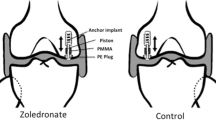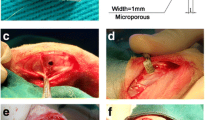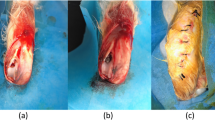Abstract
Periprosthetic bone loss, which is a direct cause of aseptic loosening in total hip arthroplasty (THA), can be suppressed by bisphosphonates. It is unknown how the quality of this bone is affected in the presence of both wear debris (from implant) and bisphosphonates. The objective of this study was to evaluate the effect of zoledronate (ZLN) on bone quality in the presence of wear debris [polyethylene (PE) particles] in a canine model of uncemented THA. Thirty dogs underwent THA, and aseptic loosening was induced via implantation of PE particles packed into the femoral component. For 26 weeks until sacrifice, two groups (each n = 10) received weekly injections of ZLN (low dose 2 μg/kg, high dose 10 μg/kg) and the third group (control) received saline. Histological and radiographic examinations were performed to evaluate the degree of implant reaction. Histomorphometry (static/dynamic) was performed to evaluate bone turnover. Back-scattered electron imaging was used to quantify the newly formed bone and to evaluate the mineralization distribution. Density fractionation and X-ray diffraction were used to evaluate mineral properties, while four-point bending was used to determine mechanical properties. A dose-dependent presence of newly formed subperiosteal bone was found, which appeared to be less mineralized than the adjacent cortical bone. The high-dose ZLN group showed decreased cortical porosity and turnover and increased mineralization profile, failure strength, and modulus. We conclude that ZLN affects some of the material properties of cortical bone and allows the newly formed subperiosteal bone to remain and therefore affect the overall quality of the bone.




Similar content being viewed by others
References
Dowd JE, Schwendeman LJ, Macaulay W, et al. (1995) Aseptic loosening in uncemented total hip arthroplasty in a canine model. Clin Orthop Relat Res 319:106–121
American Academy of Orthopedic Surgeons (AAOS). Arthroplasty and total joint replacement procedures: 1991 to 2000, http://www.aaos.org/wordhtml/research/arthropl. htm (accessed November 18, 2004)
Harris WH (1994) Osteolysis and particle disease in hip replacement. A review. Acta Orthop Scand 65:113–123
Friedman RJ, Black J, Galante JO, et al. (1993) Current concepts in orthopaedic biomaterials and implant fixation. J Bone Joint Surg Am 75:1086–1109
Shanbhag AS, Hasselman CT, Rubash HE (1997) Inhibition of wear debris mediated osteolysis in a canine total hip arthroplasty model. Clin Orthop Relat Res 344:33–43
Kadoya Y, Kobayashi A, Ohashi H (1998) Wear and osteolysis in total joint replacements. Acta Orthop Scand 278(suppl):1–16
El-Warrak AO, Olmstead M, Schneider R, et al. (2004) An experimental animal model of aseptic loosening of hip prostheses in sheep to study early biochemical changes at the interface membrane. BMC Musculoskelet Disord 5:7
Edwards MR, Egger EL, Schwarz PD (1997) Aseptic loosening of the femoral implant after cemented total hip arthroplasty in dogs: 11 cases in 10 dogs (1991–1995). J Am Vet Med Assoc 211:580–586
Ishiguro N, Kojima T, Ito T, et al. (1997) Macrophage activation and migration in interface tissue around loosening total hip arthroplasty components. J Biomed Mater Res 35:399–406
McKellop HA, Sarmiento A, Schwinn CP, et al. (1990) In vivo wear of titanium-alloy hip prostheses. J Bone Joint Surg Am 72:512–517
Doorn PF, Mirra JM, Campbell PA, et al. (1996) Tissue reaction to metal on metal total hip prostheses. Clin Orthop Relat Res 329(suppl):S187–S205
Manley MT, Serekian P (1994) Wear debris: an environmental issue in total joint replacement. Clin Orthop Relat Res 298:137–146
Kobayashi A, Freeman MA, Bonfield W et al.(1997) Number of polyethylene particles and osteolysis in total joint replacements: a quantitative study using a tissue-digestion method. J Bone Joint Surg Br 79:844–848
Allen MJ, Myer BJ, Millet PJ et al. (1997) The effects of particulate cobalt, chromium and cobalt-chromium alloy on human osteoblast-like cells in vitro. J Bone Joint Surg Br 79:475–482
Wang W, Ferguson DJ, Quinn JM et al. (1997) Biomaterial particle phagocytosis by bone-resorbing osteoclasts. J Bone Joint Surg Br 79:849–856
Bobyn JD, Glassman AH, Goto H et al. et al. (1990) The effect of stem stiffness on femoral bone resorption after canine porous-coated total hip arthroplasty. Clin Orthop Relat Res 261:196–213
Bobyn JD, Mortimer ES, Glassman AH et al. (1992) Producing and avoiding stress shielding: laboratory and clinical observations of non-cemented total hip arthroplasty. Clin Orthop Relat Res 274:79–96
Goldring MB, Schiller AJ, Roelke M (1983) The synovial-like membrane at the bone-cement interface in loose total hip replacements and its proposed role in bone lysis. J Bone Joint Surg Am 65:575–584
Thornhill TS, Ozuna RM, Shortkroff S et al. (1990) Biochemical and histological evaluation of the synovial-like tissue around failed (loose) total joint replacement prostheses in human subjects and a canine model. Biomaterials 11:69–72
Spector M, Shortkroff S, Hsu HP et al. (1992) Synovium-like tissue from loose joint replacement prosthesis: comparison of human material with a canine model. Semin Arthritis Rheum 21:335–344
Huiskes R, Weinans H, van Rietbergen B (1992) The relationship between stress shielding and bone resorption around total hip stems and the effects of flexible materials. Clin Orthop Relat Res 274:124–134
Pataki A, et al. (1997) Effects of short-term treatment with the bisphosphonates zoledronate and pamidronate on rat bone: a comparative histomorphometric study on the cancellous bone formed before, during, and after treatment. Anat Rec 249:458–468
Green JR, Müller ller K, Jaeggi KA (1994) Preclinical pharmacology of CGP 42,446, a new, potent, heterocyclic bisphosphonate compound. J Bone Miner Res 95:745–751
Cheer SM, Noble S (2001) Zoledronic acid. Drugs 61:799–805
Glatt M, Pataki A, Evans GP et al. (2004) Loss of vertebral bone and mechanical strength in estrogen-deficient rats is prevented by long-term administration of zoledronic acid. Osteoporos Int 15:707–715
Reinholz GG, Getz B, Pederson L et al. (2000) Bisphosphonates directly regulate cell proliferation, differentiation, and gene expression in human osteoblasts. Cancer Res 60:6001–6007
Im GI, Qureshi SA, Kenney J et al. (2004) Osteoblast proliferation and maturation by bisphosphonates. Biomaterials 25:4105–4115
Parfitt AM, et al. (1987) Bone histomorphometry: standardization of nomenclature, symbols, and units. Report of the ASBMR Histomorphometry Nomenclature Committee. J Bone Miner Res 2:595–610
Boyde A, Jones SJ (1983) Back-scattered electron imaging of skeletal tissues. Metab Bone Dis Relat Res 5:145–150
Grynpas MD, Hunter GK (1988) Bone mineral and glycosaminoglycans in newborn and mature rabbits. J Bone Miner Res 3:159–164
Lundon K, Dumitriu M, Grynpas M (1994) The long-term effect of ovariectomy on the quality and quantity of cancellous bone in young macaques. Bone Miner 24:135–149
Klug HP, Alexander LE (1974) X-ray diffraction procedures: for polycrystalline and amorphous materials. John Wiley & Sons, New York
An YH, Draughn RA (2000) Mechanical testing of bone and the bone-implant interface. CRC Press, New York
Bracci PM, Bull SB, Grynpas MD. (1998) Analysis of compositional bone density data using log ratio transformations. Biometrics 54:337–349
Marcellin-Little DJ, DeYoung BA, Doyens DH et al. (1999) Canine uncemented porous-coated anatomic total hip arthroplasty: results of a long-term prospective evaluation of 50 consecutive cases. Vet Surg 28:10–20
Bilston LE, Little DG, Smith NC et al. (2002) Zoledronic acid improves the mechanical properties of normal and healing bone. Clin Biomech 17:716–718
Burr DB, Miller L, Grynpas M et al. (2003) Tissue mineralization is increased following 1-year treatment with high doses of bisphosphonates in dogs. Bone 33:960–969
Wang X, Shanbhag AS, Rubash HE et al. (1999) Short-term effects of bisphosphonates on the biomechanical properties of canine bone. J Biomed Mater Res 44:456–460
Bergh MS, Muir P, Markel MD et al. (2004) Femoral bone adaptation to unstable long-term cemented total hip arthroplasty in dogs. Vet Surg 33:238–245
El-Warrak AD, Olmstead M, Apelt D et al. (2004) An animal model for interface tissue formation in cemented hip replacements. Vet Surg 33:495–504
Wedemeyer C., von Knoch F, Pingsmann A et al. (2005) Stimulation of bone formation by zoledronic acid in particle-induced osteolysis. Biomaterials 26:3719–3725
Binkley N, Kimmel D, Bruner J et al. (1998) Zoledronate prevents the development of absolute osteopenia following ovariectomy in adult rhesus monkeys. J Bone Miner Res 13:1775–1782
Grynpas MD, Kasra M, Renund R et al. (1995) The effect of pamidronate in a new model of immobilization in the dog. Bone 17:225S–232S
Otomo H, Sakai A, Ikeda S et al. (2004) Regulation of mineral-to-matrix ratio of lumbar trabecular bone in ovariectomized rats treated with risedronate in combination with or without vitamin K2. J Bone Miner Metab 22:404–414
Bohic S, Rey C, Legrand A et al. (2000) Characterization of the trabecular rat bone mineral: effect of ovariectomy and bisphosphonate treatment. Bone 26:341–348
Fratzl P, Schreiber S, Roschger P et al. (1996) Effects of sodium fluoride and alendronate on the bone mineral in minipigs: a small-angle X-ray scattering and backscattered electron imaging study. J Bone Miner Res 11:248–253
Little DG, Smith NC, Williams PR et al. (2003) Zoledronic acid prevents osteopenia and increases bone strength in a rabbit model of distraction osteogenesis. J Bone Miner Res 18:1300–1307
Acknowledgments
This study was supported by grants from the Canadian Institutes of Health Research and the Novartis Company.
Author information
Authors and Affiliations
Corresponding author
Rights and permissions
About this article
Cite this article
Wise, L.M., Waldman, S.D., Kasra, M. et al. Effect of Zoledronate on Bone Quality in the Treatment of Aseptic Loosening of Hip Arthroplasty in the Dog. Calcif Tissue Int 77, 367–375 (2005). https://doi.org/10.1007/s00223-005-0062-3
Received:
Accepted:
Published:
Issue Date:
DOI: https://doi.org/10.1007/s00223-005-0062-3




